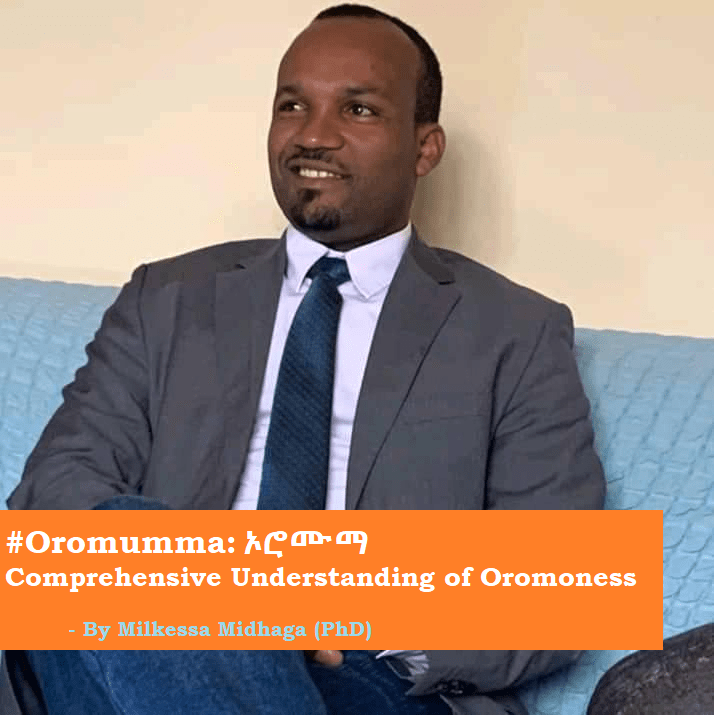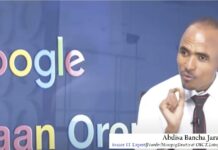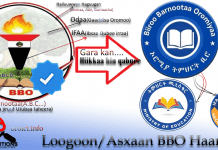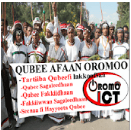In the 1960s, it was not the concept of Oromoness (hereafter Oromumma) which was conceptually debated. It was Ethiopia and who constitutes Ethiopian which was at the center of ‘the nationalities question’ as formulated by Ethiopian Student Movement leaders such as Ibsa Gutema, Walelign Mekonen, Muhe Abdo and others. At the time, Ethiopianess, in terms of cultural stuff—language, music, way of life—, politics and religion, was equated with Amharaness (and to some extent Amhara- Tigrawayness) (see Walelign Mekonen’s six page masterpiece).
Due to the whole process of state formation and the subsequent “nation-building” project of the ancien regime, and the resultant resistance it had to face from the conquered nations, Donald Levine summed it the whole process as “Amhara thesis”, “Oromo anti-thesis” and “Ethiopian synthesis”. Levine’s formulation was criticized only for narrowly defining it from two major national groups. Backed by historically failed nostalgic project of building “Amharic speaking one-nation of Ethiopia”, a section of Ethiopian elites continued to advance anti-Oromo envisaged Ethiopia.
Recently, the concept of Oromumma has become, let me say, agenda of discussions and debates among many. That initiated me to refer back literature and my own experiences. Thus, it is important, at this historical juncture, that we all have full picture of what Oromummaa is and what it is not. I am not a social- anthropologist, but a student of political science just to admit my scholarly gaps.
#Understanding_Oromumma: A holistic Approach
#Oromummaa is a broader concept. It is explained by the totality of Oromo culture. It is much deeper and complex than what we think. It is explained in terms of cultural stuff (norms, values, traditions), languages, belief systems, arts, history and tradition, jiruuf-jireenya (work and life), worldview/philosophy, democratic values, symbolism and identity, landed concept, and socially integrating ‘others’.
“Oromumma, derived from the name Oromo, refers to all those elements that constitute the Oromo personality. […]. In short, ‘Oromoness’ is composed of the totality of the Oromo culture” (Gemechu Megersa, 1996: p.92). Oromo traditions provide the basics of Oromumma. No nation without its own history. Oromo is an ancient people in the Northeast Africa. Oromumma is built on the knowledge of the history of the Oromo. There are also traditions that nurture Oromumma from childhood. Hibbo (riddle) is played by youths in the night. It is a mental exercise; in modern terms, IQ development strategies. Knowledge of mammaaksa (Oromo proverbs) is critical. In the Oromo tradition, “mammaaksi dubbii fixuuf ykn dubbii fiduuf” (proverbs either resolve or cause a dispute), is the part of the day-to-day activity of the Oromo society. The appropriate usage of Oromo’s mammaaksa is critical element of Oromumma. Oromo elders begin discussions, and conclude them with mammaaksa. One of the targets of assimilation policy was this mammaaksa and its usage, making generations to forget their own and adopt the nationally prescribed ones. Such strategies of weakening aspect of Oromumma has always been subtle.
#Moggaasa_Maqaa: A newly born baby should get name, and it must be approved by appropriate traditional institution. Oromo naming for newly born baby or adopted ones is not an arbitrary phenomenon. You must follow the procedure. Systematic name changing was also an act of assimilation policy of Ethiopia to weaken Oromumma. Those with rotten assimilationist mentality, I am sure, hate my name, Milkessa, as an “un-Ethiopian” name. Well, Gaddisa, Tolashii, Guyyo, Iftu are beautiful Ethiopian names enriched with Oromumma moggaasa maqaa (naming).
#Oromo_arts_and_literary traditions characterize Oromumma. As you distance yourself from Oromo music and arts, you will be engulfed with others as globalization is dominating. All music and arts carry messages and cultural values that they want to inculcate in the minds of the listeners. So, Oromo music and arts transmits Oromumma. There many kinds of music and arts—it takes the form singing for love of couples or nation, history, resistance, ritual, mobilization and for hero/heroine [geerarsa], cultural, marriage, nature, for cattle, education, etc. Art is comprehensive. Ali Birra’s everlasting songs are themselves bearers of Oromumma.
#Oromumma_and_Afaan_Oromo: Language, above all, is a carrier of all cultural stuffs. Language is not a mere means of communication. It carries cultural values of the nation and transfer them from generation to generation. A people without its own language is only half a nation, as linguists put. When they kill your language, they are killing your cultures as well. That is why language became the key target of assimilation policies of “nation-builders.” ‘Nation-building’ in this regard is ‘nation-destroying’ (see Walker Connor). Who said “kill the tribes to build a nation?” Thus, to lose one’s own language is the worst badge of conquest. When you lose your Afaan Oromo, you automatically lose aspects Oromo traditions, which harts Oromumma.
Oromumma can be achieved in two ways. One is to be born Oromo. The other is ‘to become’ Oromo. Paul Baxter calls it being and becoming Oromo. In the later, non-Oromos can become Oromo once they pass through strict legal and cultural procedures called #Moggasaa — of adoption. You can also stop the adoption processes on the medhacha stage and retain your language and community; but this compromises your political rights in Oromo. Full adoption renders full citizenship. Moggaasaa is for group adoption (collectively) and #Guddifacha is an individual approach. One must be clear that adoption in Oromo society is fully dependent upon the consent of the adoptees. There has never been forced/compulsory adoption in Gadaa system. Because the adoptees are attracted by economic benefits in the clans and democratic nature of the egalitarian system, it was a free enterprise. Once fully adopted, you can run for Abba Gadaa posts. Note that such socially integrative approach worked well during the well-functioning of the Gadaa system. Once Gadaa system started to weaken, the becoming aspect of Oromumma get corrupted and abused, especially the ‘unsuccessful integrations’ causing ‘a regaining former identity’, which in many places are causes of conflicts.
Asserting one’s own Oromo identity (exercising Oromumma) and devotion to demonstrate basic features of Oromo culture is a key. You need to be proud of being or becoming Oromo. Social-anthropologists call this activity self-consciousness. Commitment at this stage helps the advancement of Oromo culture. It includes defending your Oromumma.
#Oromumma_and_Oromo_philosophy: Oromumma is distinguished with “core common cultural values and modes of thought” (Baxter, 1985:1). Oromo philosophy is an African philosophy which is distinct from oriental philosophies. Oromo life is largely a collective life just as other African societies. Individualism is uncommon in Oromo philosophy. Be it good or bad, in Oromo society, you just share them in common. For example, for a crime an individual commits the clan is collectively accountable. That is why you find less crime rates in Borana than any other places. “I am because we are”, not the other way round. That is why, liberalism, founded on individualism, can rarely be implemented in Oromo society. Oromumma as a collectivism is embedded in Oromo worldviews.
#Political_aspects_of_Oromumma: Oromo as society is a democratic & open society. That has roots in Gadaa system. Power is transferred from one party to the next democratically. There are five political parties (Gogeessa Gadaa) in Oromo. Each term of office is fixed, eight years. Once you finish your eight year term, you live the office to the next party. No re-election of Abba Gadaa. No deception. No power is gained through barrel of the gun. No son has ever killed his father for power. No soldier takes state power. Gadaa democracy is an amazing well founded system. Oromumma is built on top of that democratic political culture. Honest and trust is the basis of Gadaa politics.
Symbolically, #Odaa (scamore tree) used to function as an assembly hall (galma). It is a symbol of Oromo institution. “Teessu dhugaa baasi, dhaabattu mataa kee baasi” means “you search for truth when seating under Odaa, and you are told to defend yourself when standing in front of the ‘modern’ court” shows us how much the Oromo are honest under Odaa. Odaa is part of the identity of the Oromo. That is why all Oromo organizations (both government and opposition, political or social, almost all Oromo institutions) use Odaa in their emblems, flags, and others. Odaa and activities under it (i.e., committed to the truth) are deeply rooted in Oromumma.
#Oromumma_is_tied_to_Oromoland. Mountains and rivers have traditional ritual and non-ritual functions in Oromo society. “Yaa Oromoo warra uumaan buluu keenya abboonni tulluu fi malkaatti baha duruu.” Oromo’s jiruuf-jireenya (work and life) is tied to its land. Extended families inherit land from their forefathers. “Yaa Oromo qulqullu qonneet nyaanna lafan gurgurru” was a key Oromo’s song against that infamous master plan of Finfinne. Youths, if they can’t resolve the riddles, they are expected to render land. That is why land is the foundation of Oromo’s jiruuf-jireenya and cultural values.
Oromummaa had also belief system dimension (now become cultural rules of the society), which means, before they convert into dominant religions of the world, Oromo had worship one #Waaqaa (God) as monotheist society. Dhugaan ilma Waaqi (truth is the son of God) was one of the founding principles of Waqeffanna religion of the day. Safuu was at the core of Oromumma. You never deceive, never lie, because it is Safuu! Safuu means all wrong things that are forbidden culturally. Oromummaa as God obeying act, hence built God-fearing society of Oromo.
#Irreecha (thanksgiving) festival, celebrated twice a year (Irreecha Birraa and Irreecha Arfaasaa), is well known to the world. As it is being regained and getting momentum, we are only emphasizing on only Irreecha Birraa, celebrated in Fulbaana (September). I am sure, it is a matter of time that Irreecha will be recognized as one of the national holydays integrating into the national calendar of Ethiopia. Indicating Oromummaa becoming Ethiophiyumma.
Oromo has its own #calendar counting based on lunar system (star observation). Still this calendar is active in Borana (both Ethiopia and Kenya) (see Asmarom Legese). An Oromo calendar is part of Oromumma features. Very few old people still count the Oromo calendar as part of their Oromoness.
In #conclusion, Oromumma is a broader and deeper concept. It is explained in terms of history to tradition, arts to beliefs/values, symbols to democracy, identity to integration, language to philosophy, Oromoland to Oromo calendar. It begins with being and becoming. You can’t pick only one feature up to define Oromumma. There is no Oromo without Oromumma. I don’t remember the days Oromumma existed without Oromo as well. Due to external factors, you may lose some aspects of Oromumma but you can retain basics of Oromumma. Since the formation of the modern Ethiopian empire state, the Oromo ‘personal’ continued to be political to certain establishments. This is unfortunate. Oromumma must be depoliticized. I believe Oromumma can be part and parcel of Ethiophiyumma. I don’t understand the meaning of Ethiopianess that compromises Oromumma. For me, Ethiophiyumma is Somalumma, Ethiophiyumma is Tegarumma, Oromumma, Amharumma, Sidamumma, Afarumma and all that are in Ethiopia. Some dream that Oromumma can be destroyed, and boldly claim that it is withering away. That is purely a day dream. Though historically tried formally by the state through deliberate consecutive national policies of assimilation, it miserably failed. As Oromumma is attached to the lives of the Oromo people, it might look weakened but it has never been weakened as they thought even during those dark old days. It is totally wrong and outdated to think that “to become a ‘good Ethiopian’, an Oromo must denounce its Oromumma”. The answer is obvious. Gemechu Megersa once correctly said “the Oromo will never become good Ethiopians before they become good Oromo”.
—————–
May21, 2020, Finfinne









